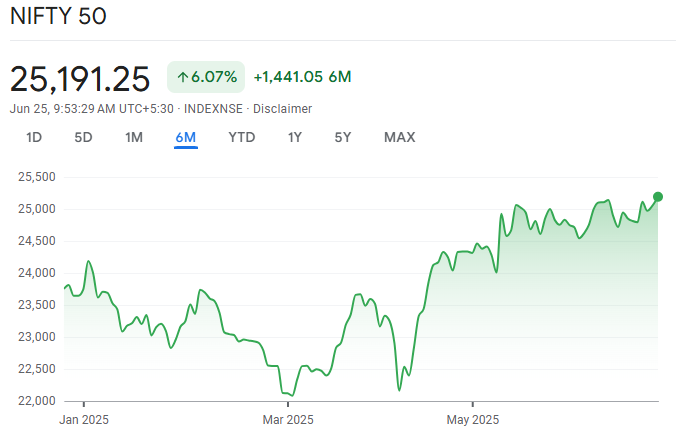The Nifty 50 Index is one of India's most prominent stock market benchmarks, widely followed by investors, traders, and financial analysts. It reflects the performance of the top 50 large-cap companies listed on the National Stock Exchange (NSE) of India.
For those seeking to comprehend the Indian stock market, gaining knowledge about the Nifty 50 is a good starting point.
This comprehensive beginner's guide will walk you through everything you need to know about the Nifty 50—its definition, components, why it matters to investors, and how to trade or invest in it.
Understanding the Nifty 50 Index

The Nifty 50 Index was introduced in 1996 by NSE Indices Limited and is overseen by the National Stock Exchange. It serves as a barometer of the Indian equity market, tracking the performance of 50 major companies from 14 sectors of the economy.
These companies are selected based on free-float market capitalisation and liquidity, which ensures the index reflects the broad market sentiment.
The Nifty 50 plays a similar role in India that indices like the S&P 500 do in the United States. It gives a snapshot of the market's overall health and is often used as a benchmark to evaluate the performance of mutual funds, ETFs, and portfolio managers.
History and Evolution
Introduced in April 1996, the Nifty 50 began with a base value of 1000 points and a base year of 1995. Since its inception, the index has witnessed several milestones that reflect India's economic evolution.
From the tech boom of the early 2000s to the 2008 financial crisis and the rapid digital expansion post-2020, the Nifty 50 has captured all major market movements.
Over time, the composition of the index has changed as companies are added or removed based on eligibility criteria. This dynamic nature ensures that the Nifty 50 remains relevant and representative of the current market structure.
Composition of the Nifty 50

The Nifty 50 comprises 50 firms from diverse sectors, including financial services, information technology, energy, consumer goods, and healthcare. Some of the notable names include:
These companies represent approximately 60-70% of the total free-float market capitalisation of the NSE, making the Nifty 50 a strong indicator of market performance.
The sectoral representation is reviewed semi-annually, and the index is rebalanced to ensure accuracy and relevancy.
Why Does the Index Matter?
For retail and institutional investors, the Nifty 50 serves multiple critical functions. It is a performance benchmark, an investment option, and a tool for economic analysis.
Benchmarking Tool
The majority of Indian mutual funds measure their performance against the Nifty 50. It acts as a benchmark for fund managers and investors to measure success.
Market Sentiment Indicator
The daily fluctuations of the Nifty 50 are frequently reported in financial news and regarded as a gauge of investor sentiment. An increasing Nifty usually indicates optimism, whereas a declining index might signify fear or negativity.
Investment Vehicle
Through Nifty 50-linked ETFs, futures, and options, both retail and institutional investors can directly invest in or trade the index. It offers access to India's economy without specific stocks.
Nifty 50 Index Performance in 2025 So Far

January and Early-Year Weakness
Weak start: January 2025 began with a dip in small- and mid-cap stocks—the worst in eight months—which reflected broader caution. While this drop didn’t immediately hit the Nifty 50 hard, it foreshadowed soft sentiment.
In early February, intensified global trade tensions, policy headwinds, and U.S. tariff concerns triggered a sharp pullback. The Nifty fell swiftly, even slipping below critical support levels. It sparked the first substantive drop since mid‑2024.
March: The Rebound Begins
Mid-March recovery: After bottoming out, foreign institutional investors (FIIs) returned, buying into beaten-down stocks. Over six straight sessions, the Nifty reversed its YTD losses, turning positive by late March.
By March 24, the index surged past 23,700 and reclaimed the green following a 4% weekly rally, signalling strong renewed interest.
April–May: Sustained Rally
Domestic buying dominates: Through April and May, Indian asset managers rotated capital into financials, consumer goods, defence, and healthcare. This shift powered an 8% rally from late April lows.
The Nifty 50 recorded around a 12% increase from March to May, supported by reduced trade conflicts and strong corporate profits. FIIs infused approximately $2.66 billion in this rally.
June: Plateau and Stalemate
Nifty stalls near 25,000: In June, the index faced resistance around the 25,000 mark. It closed above this level seven times but struggled to stay above it for more than four consecutive sessions.
Mixed sentiment: Big money appears cautious; FIIs opened nearly $2 billion in short futures positions, yet retail traders maintained bullish exposure of about $1.54 billion.
Range-bound trend: After climbing from ~21,744 to 25,116 (a ~16% gain), the Nifty stayed within a narrow 1,000-point band across 19 trading sessions.
Mid-June Surge
On June 24, hope for a ceasefire between Iran and Israel and a decline in global crude prices benefited oil-importing India. The Nifty jumped nearly 1% to 25,225, matching highs not seen since October 2024.
Strategy Tips Mid-Year
Long on dips: With Q2 resilience and technical support from 24,700–24,800, tactical entries could work on pullbacks.
Protective hedging: Given stretched valuations and FII cautiousness, consider modest hedges via index put options.
Watch catalysts: U.S. Fed commentary, crude price moves, and India’s CPI/PPI data can trigger breakouts from the current choppy range.
Positioning bias: Technical break and hold above 25,300–25,500—especially on strong volume—may signal the next leg higher. On the other hand, a decline to 24,700 amist global pressure updates could result in a more significant pullback.
How to Invest in the Nifty 50 Index
index funds
Nifty 50 index funds replicate the composition of the index. These passively managed mutual funds aim to generate returns that closely track the Nifty 50. They are ideal for long-term investors looking for diversification and low fees.
Exchange-Traded Funds (ETFs)
Nifty 50 ETFs are listed on stock exchanges and trade like regular shares. They offer real-time pricing and liquidity, making them suitable for both short- and long-term strategies.
Futures and Options
Nifty futures and options are popular derivatives instruments used for hedging, speculation, and arbitrage. However, they require a deeper understanding of risk and market behaviour, so we would not recommend it to beginners without proper training.
Conclusion
In conclusion, the Nifty 50 Index is a cornerstone of India’s stock market and a powerful tool for understanding market behaviour. Whether you’re a passive investor looking for long-term exposure to India's growth story or an active trader seeking momentum opportunities, the Nifty 50 has something to offer.
In early 2025, the Nifty 50 shows stability despite a sluggish winter and a robust spring, held back by psychological limits and careful capital movement. Traders ought to prioritise disciplined strategies with well-defined risk management before expected volatility triggers.
Disclaimer: This material is for general information purposes only and is not intended as (and should not be considered to be) financial, investment or other advice on which reliance should be placed. No opinion given in the material constitutes a recommendation by EBC or the author that any particular investment, security, transaction or investment strategy is suitable for any specific person.
























